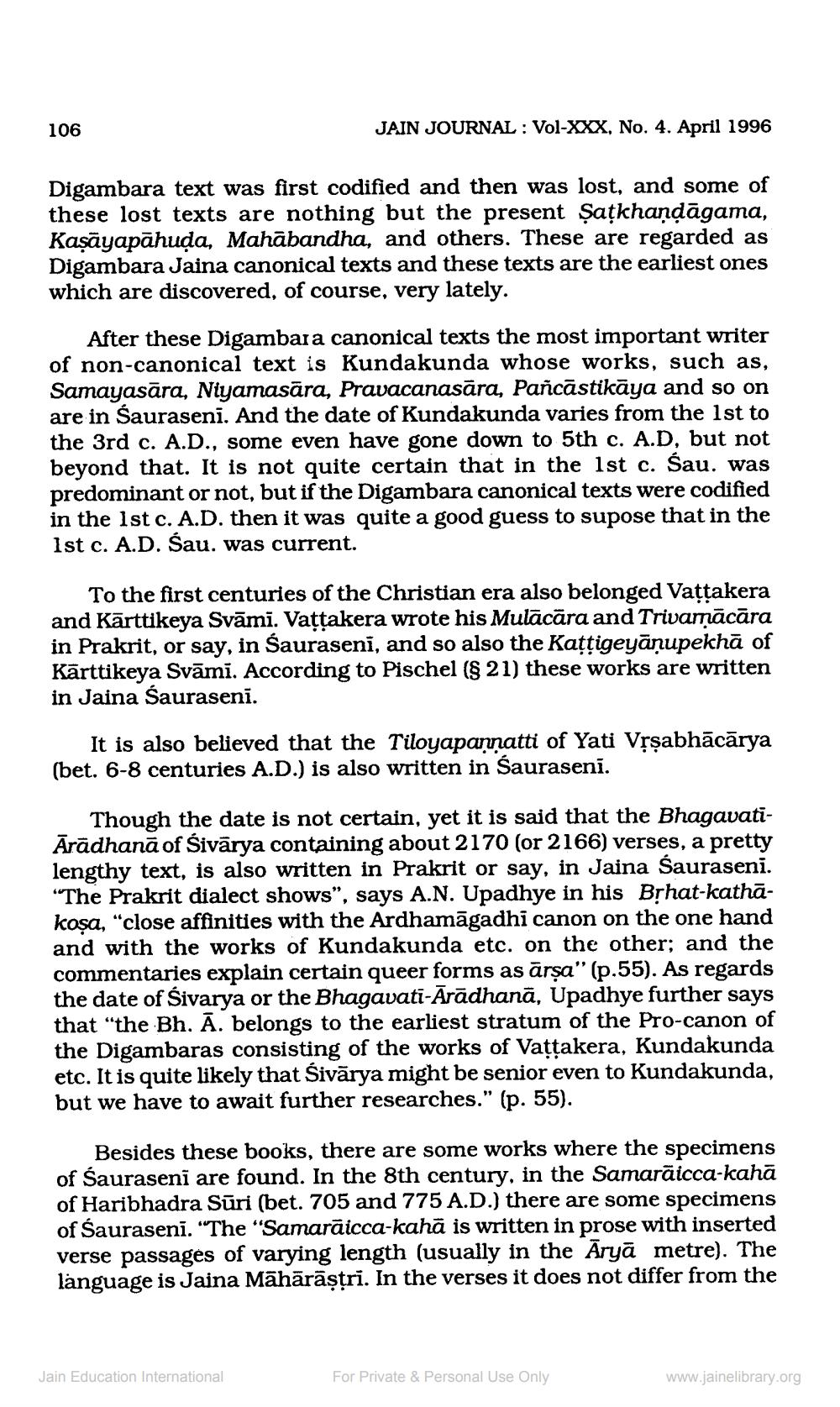Book Title: Jain Journal 1996 04 Author(s): Jain Bhawan Publication Publisher: Jain Bhawan Publication View full book textPage 8
________________ 106 JAIN JOURNAL: Vol-XXX, No. 4. April 1996 Digambara text was first codified and then was lost, and some of these lost texts are nothing but the present Saṭkhaṇḍāgama, Kaṣāyapāhuḍa, Mahābandha, and others. These are regarded as Digambara Jaina canonical texts and these texts are the earliest ones which are discovered, of course, very lately. After these Digambar a canonical texts the most important writer of non-canonical text is Kundakunda whose works, such as, Samayasara, Niyamasāra, Pravacanasāra, Pañcāstikāya and so on are in Śauraseni. And the date of Kundakunda varies from the 1st to the 3rd c. A.D., some even have gone down to 5th c. A.D, but not beyond that. It is not quite certain that in the 1st c. Śau. was predominant or not, but if the Digambara canonical texts were codified in the 1st c. A.D. then it was quite a good guess to supose that in the 1st c. A.D. Śau. was current. To the first centuries of the Christian era also belonged Vaṭṭakera and Karttikeya Svāmi. Vaṭṭakera wrote his Mulācāra and Trivamṇācāra in Prakrit, or say, in Sauraseni, and so also the Kaṭṭigeyāņupekhā of Kārttikeya Svāmi. According to Pischel (§ 21) these works are written in Jaina Śauraseni. It is also believed that the Tiloyapannatti of Yati Vṛṣabhācārya (bet. 6-8 centuries A.D.) is also written in Sauraseni. Though the date is not certain, yet it is said that the BhagavatiĀrādhana of Śivarya containing about 2170 (or 2166) verses, a pretty lengthy text, is also written in Prakrit or say, in Jaina Sauraseni. "The Prakrit dialect shows", says A.N. Upadhye in his Bṛhat-kathākoşa, "close affinities with the Ardhamāgadhi canon on the one hand and with the works of Kundakunda etc. on the other; and the commentaries explain certain queer forms as ārṣa" (p.55). As regards the date of Śivarya or the Bhagavati-Ārādhanā, Upadhye further says that "the Bh. A. belongs to the earliest stratum of the Pro-canon of the Digambaras consisting of the works of Vaṭṭakera, Kundakunda etc. It is quite likely that Śivarya might be senior even to Kundakunda, but we have to await further researches." (p. 55). Besides these books, there are some works where the specimens of Sauraseni are found. In the 8th century, in the Samaraicca-kahā of Haribhadra Suri (bet. 705 and 775 A.D.) there are some specimens of Sauraseni. "The "Samaraicca-kaha is written in prose with inserted verse passages of varying length (usually in the Arya metre). The language is Jaina Māhārāṣṭri. In the verses it does not differ from the Jain Education International For Private & Personal Use Only www.jainelibrary.orgPage Navigation
1 ... 6 7 8 9 10 11 12 13 14 15 16 17 18 19 20 21 22 23 24 25 26 27 28 29 30 31 32 33 34 35 36 37 38 39 40 41 42 43 44 45 46 47 48 49 50 51 52 53 54 55
